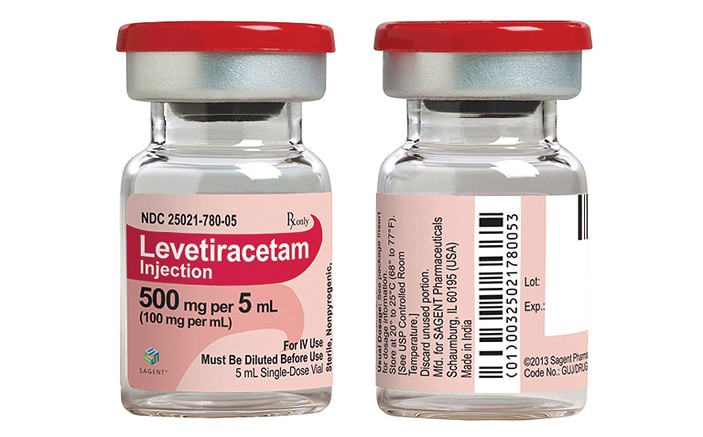Though relatively new on the anti-epileptic scene, levetiracetam (LEV) has rapidly become a favorite medication for seizure treatment and for status epilepticus because of its rapid onset of action, good side effect profile, and minimal interactions with other medications.
How it Works
The actual mechanism of action of levetiracetam is not well understood. It is known to bind to a synaptic vesicle protein, SV2A, and it inhibits calcium channels in the presynaptic neuron. However, it is not completely clear how this reduces seizure activity.
Major Indications
Levetiracetam, brand named Keppra, is FDA-approved as adjunctive therapy to treat partial onset seizures in patients over one month of age, for tonic-clonic seizures in patients’ age six years and up, and for myoclonic seizures in patients over 12 years old. It is used off-label in patients with status epilepticus over age one month and for seizure prophylaxis in patients with a sub-arachnoid hemorrhage.
Notable History
Levetiracetam was first approved in the United States in 1999,1 and has been available IV since 2006.2,3 A generic version was FDA-approved in 2008.
In the News
A recent meta-analysis found levetiracetam was effective for terminating benzodiazepine-resistant status epilepticus in almost 70% of cases, a rate comparable to phenobarbital and valproate, and better than phenytoin.4 A pilot study of levetiracetam compared with lorazepam as a first-line agent for early status epilepticus found the two medications were both effective in terminating seizures within 10 minutes, and the patients who received levetiracetam had less respiratory depression.5 However, this was a small, non-blinded study of 79 patients, and benzodiazepines are still currently considered first-line agents for status epilepticus.
Adverse Events
Serious adverse events are rare. About 1 in 3,000 patients taking levetiracetam may develop Stevens Johnson Syndrome.6 In general patients may experience some mild sedation. Mood disturbance and psychiatric adverse effects such as hallucinations can rarely occur, and may be more of a problem in patients with dementia or with underlying developmental delay. Some studies showed an increased risk of upper respiratory infections.8
Cautions
Levetiracetam is pregnancy class C, and some animal studies have shown developmental abnormalities in the fetus.7 Keppra is not a reason to discontinue breastfeeding, as there are low levels in breast milk.
Dosing and adjustments
The oral and IV dosing are the same, which makes it easier to remember. For treatment of a seizure disorder, the dose is typically 500mg BID for adults, or 10mg/kg BID for children. The dose can be increased by 1000mg every two weeks to a maximum total of 4000mg daily in adults or up to 20mg/kg children if needed. An extended release form also exists.9 It is renally cleared so doses should be reduced for patients with impaired renal function. For patients on hemodialysis, the dose is 500mg to 1000mg daily plus an additional 250-500mg dose after hemodialysis. Levetiracetam is used off-label as a second- or third-line agent (after benzodiazepines) in status epilepticus at a dose of 20mg/kg IV.3 It has fewer side effects and is less sedating compared with other drugs used for status epilepticus, such as phenytoin/fosphenytoin, and phenobarbital and has a rapid onset of action.
Serum levetiracetam levels can usually be obtained in the hospital’s laboratory to assure therapeutic levels, especially when patients present with breakthrough seizures.
Special Considerations
Because levetiracetam is not metabolized by and does not up- or down-regulate the cytochrome P450 pathways, it does not have any significant drug-drug interactions, making it ideal for adjunctive therapy with other antiepileptic drugs.7
Cost
IV levetiracetam costs about $50 for one 1000mg dose. Oral levetiracetam tablets cost about $200 for one month’s supply (60) of the 500mg tablets, and $275 for one month’s supply (60) of the 750mg tablets. The non-generic form, Keppra, and the extended release formulation tablets that allow once-daily dosing are more expensive.7
REFERENCES
- Abou-Khalil B. Levetiracetam in the treatment of epilepsy. Neuropsychiatr Dis Treat. 2008;4(3):507-523.
- Ramael S, Daoust A, Otoul C, et al. Levetiracetam intravenous infusion: A randomized, placebo-controlled safety and pharmacokinetic study. Epilepsia. 2006;47(7):1128-1135.
- Trinka E, Hofler J, Leitinger M, Brigo F. Pharmacotherapy for status epilepticus. Drugs. 2015;75(13):1499-1521.
- Yasiry Z, Shorvon SD. The relative effectiveness of five antiepileptic drugs in treatment of benzodiazepine-resistant convulsive status epilepticus: A meta-analysis of published studies. Seizure. 2014;23(3):167-174.
- Misra UK, Kalita J, Maurya PK. Levetiracetam versus lorazepam in status epilepticus: A randomized, open labeled pilot study. J Neurol. 2012;259(4):645-648.
- Griebel ML. Acute management of hypersensitivity reactions and seizures. Epilepsia. 1998;39 Suppl 7:S17-21.
- Lexicomp. Levetiracetam: Drug information. Up To Date Web site. uptodate.com. Accessed 09/10, 2015.
- Delanty N, et al. ‘Adjunctive Levetiracetam In Children, Adolescents, And Adults With Primary Generalized Seizures: Open-Label, Noncomparative, Multicenter, Long-Term… – Pubmed – NCBI ‘. Ncbi.nlm.nih.gov. N. p., 2015. Web. 5 Oct. 2015.
- http://www.ncbi.nlm.nih.gov/pubmed?term=19777068








